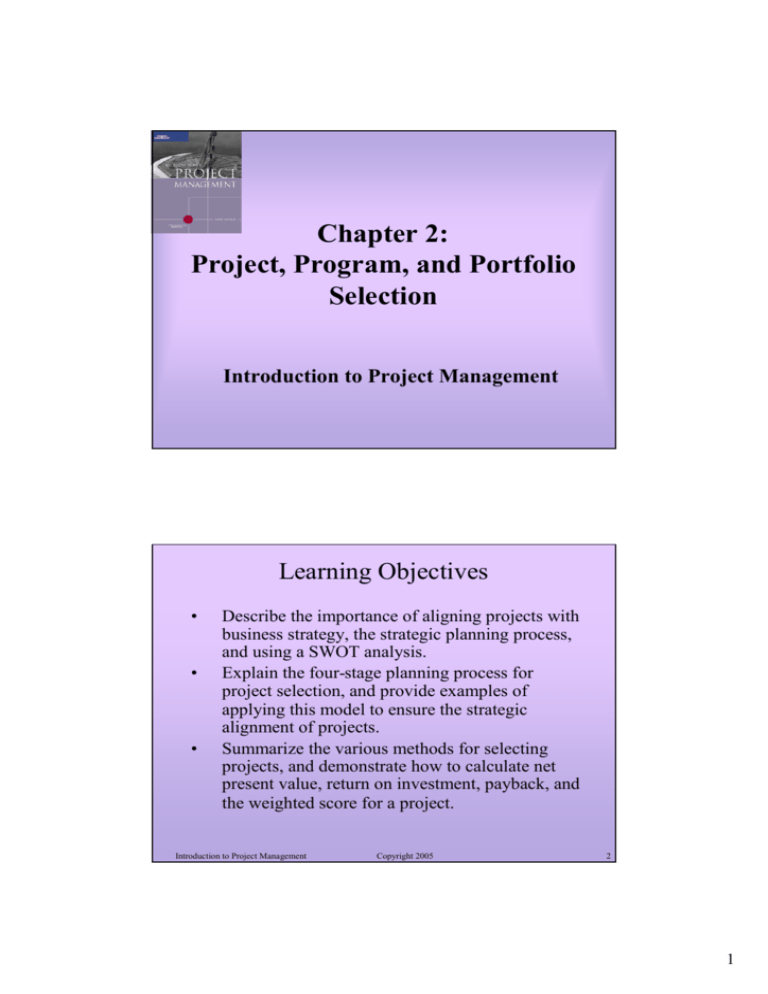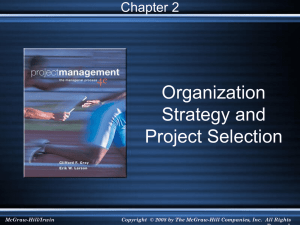Chapter 2: Project, Program, and Portfolio Selection
advertisement

Chapter 2: Project, Program, and Portfolio Selection Introduction to Project Management Learning Objectives • • • Describe the importance of aligning projects with business strategy, the strategic planning process, and using a SWOT analysis. Explain the four-stage planning process for project selection, and provide examples of applying this model to ensure the strategic alignment of projects. Summarize the various methods for selecting projects, and demonstrate how to calculate net present value, return on investment, payback, and the weighted score for a project. Introduction to Project Management Copyright 2005 2 1 Learning Objectives (continued) • Discuss the program selection process, and distinguish the differences between programs and projects. • Describe the project portfolio selection process and the five levels of project portfolio management. Introduction to Project Management Copyright 2005 3 Aligning Projects with Business Strategy • Most organizations cannot undertake most of the potential projects identified because of resource limitations and other constraints. • An organization’s overall business strategy should guide the project selection process and management of those projects. Introduction to Project Management Copyright 2005 4 2 What Went Wrong? • With little analysis, an organization selected an enterprise resource planning package and hired a firm to assist with the implementation. • They did not formally define the benefits of the new system or decide exactly which processes were to be redesigned. • The project was completed over budget and behind schedule, and instead of helping the company, it prevented it from closing its books for over twelve months. Introduction to Project Management Copyright 2005 5 Strategic Planning • Strategic planning involves determining long-term objectives by analyzing the strengths and weaknesses of an organization, studying opportunities and threats in the business environment, predicting future trends, and projecting the need for new products and services. • Strategic planning provides important information to help organizations identify and then select potential projects. Introduction to Project Management Copyright 2005 6 3 SWOT Analysis • SWOT analysis involves analyzing Strengths, Weaknesses, Opportunities, and Threats. • It can help you identify potential projects, as is shown in the example about four people trying to start a new business. Introduction to Project Management Copyright 2005 7 Four Stage Strategic Planning Process for Project Selection • Organizations often follow a detailed planning process for project selection. • Figure 2-1 shows a four-stage planning process for selecting projects. • It is very important to start at the top of the pyramid to select projects that support the organization’s business strategy. Introduction to Project Management Copyright 2005 8 4 Figure 2-1. Pyramid for the Project Selection Process Introduction to Project Management Copyright 2005 9 Methods for Selecting Projects • Focus on competitive strategy and broad organizational needs. • Perform net present value analysis or other financial projections. • Use a weighted scoring model. • Implement a balanced scorecard. • Address problems, opportunities, and directives. • Consider project time frame. • Consider project priority. Introduction to Project Management Copyright 2005 10 5 Figure 2-2. Your Turn to Throw! Not a good way to select projects! Introduction to Project Management Copyright 2005 11 Focusing on Competitive Strategy and Broad Organizational Needs • Competitive strategies: – Cost leadership: Attract customers primarily because products or services are inexpensive. Examples include Walmart and Cub Foods. – Focus: Develop products and services for a particular market niche. Examples include Babies “R” Us and Ron Jon Surf Shop. • Broad organizational needs: People agree there is a need for a project, they will make funds available, and there is a strong will to make the project succeed. Introduction to Project Management Copyright 2005 12 6 Performing Financial Projections • Financial considerations are often an important aspect of the project selection process. • Three important methods include: – Net present value analysis – Return on investment – Payback analysis Introduction to Project Management Copyright 2005 13 Net Present Value Analysis • Net present value (NPV) analysis is a method of calculating the expected net monetary gain or loss from a project by discounting all expected future cash inflows and outflows to the present point in time. • NPV means the return from a project exceeds the opportunity cost of capital— the return available by investing the capital elsewhere. • Projects with higher NPVs are preferred to projects with lower NPVs if all other factors are equal. Introduction to Project Management Copyright 2005 14 7 Figure 2-3. Net Present Value Example Notice that the sum of the cash flow— benefits minus costs, or income minus expenses— is the same for both projects at $5,000. Introduction to Project Management Copyright 2005 15 Figure 2-4. Detailed NPV Calculations Introduction to Project Management Copyright 2005 16 8 NPV Considerations • Some organizations refer to the investment year(s) for project costs as Year 0 instead of Year 1 and do not discount costs in Year 0. • The discount rate can vary, based on the prime rate and other economic considerations. • You can enter costs as negative numbers instead of positive numbers, and you can list costs before benefits. • Project managers should check to see which approaches their organizations prefer when calculating NPV. Introduction to Project Management Copyright 2005 17 Figure 2-5. Intranet Project NPV Example Introduction to Project Management Copyright 2005 18 9 Steps for Calculating NPV 1. Determine the estimated costs and benefits for the life of the project and the products it produces. 2. Determine the discount rate. A discount rate is the rate used in discounting future cash flows. The annual discount factor is a multiplier for each year based on the discount rate and year (calculated as 1/(1+r)t, where r is the discount rate, and t is the year). 3. Calculate the net present value by subtracting the total discounted costs from the total discounted benefits. Introduction to Project Management Copyright 2005 19 Return on Investment • Return on investment (ROI) is the result of subtracting the project costs from the benefits and then dividing by the costs. • For example, if you invest $100 today and next year your investment is worth $110, your ROI is ($110 – 100)/100, or 0.10 (10 percent). • Note that the ROI is always a percentage, and the higher the ROI, the better. • Many organizations have a required rate of return for projects— the minimum acceptable rate of return on an investment. • You can find the internal rate of return (IRR) by finding what discount rate results in an NPV of zero for the project. Introduction to Project Management Copyright 2005 20 10 Payback Analysis • Payback period is the amount of time it will take to recoup— in the form of net cash inflows— the total dollars invested in a project. • Payback analysis determines how much time will lapse before accrued benefits overtake accrued and continuing costs. • Payback occurs in the year when the cumulative benefits minus costs reach zero. • The shorter the payback period, the better. Introduction to Project Management Copyright 2005 21 Figure 2-6. Charting the Payback Period Introduction to Project Management Copyright 2005 22 11 Weighted Scoring Models • A weighted scoring model is a tool that provides a systematic process for selecting projects based on many criteria. • To create a weighted scoring model: – Identify criteria important to the project selection process. – Assign a weight to each criterion (so they add up to 100 percent). – Assign numerical scores to each criterion for each project. – Calculate the weighted scores by multiplying the weight for each criterion by its score and adding the resulting values. Introduction to Project Management Copyright 2005 23 Figure 2-7. Sample Weighted Scoring Model for Project Selection Introduction to Project Management Copyright 2005 24 12 Implementing a Balanced Scorecard • Dr. Robert Kaplan and Dr. David Norton developed another approach to help select and manage projects that align with business strategy. • A balanced scorecard is a methodology that converts an organization’s value drivers— such as customer service, innovation, operational efficiency, and financial performance— to a series of defined metrics. • Visit www.balancedscorecard.org for more information on using this approach to select projects. Introduction to Project Management Copyright 2005 25 Problems, Opportunities, and Directives • Problems are undesirable situations that prevent an organization from achieving its goals. These problems can be current or anticipated. • Opportunities are chances to improve the organization. • Directives are new requirements imposed by management, government, or some external influence. Introduction to Project Management Copyright 2005 26 13 Project Time Frame • Another approach to project selection is based on the time it will take to complete a project or the date by which it must be done. • For example, some potential projects must be finished within a specific time period. If they cannot be finished by this set date, they are no longer valid projects. • Some projects can be completed very quickly— within a few weeks, days, or even minutes. However, even though many projects can be completed quickly, it is still important to prioritize them. Introduction to Project Management Copyright 2005 27 Project Priority • Many organizations prioritize projects as being high, medium, or low priority based on the current business environment. • Organizations should always focus on high-priority projects. Introduction to Project Management Copyright 2005 28 14 Program Selection • Recall that a program is a group of projects managed in a coordinated way to obtain benefits and control not available from managing them individually. • After deciding which projects to pursue, organizations need to decide if it is advantageous to manage several projects together as part of a program. • There might already be a program that a new project would logically fall under, or the organization might initiate a program and then approve projects for it. Introduction to Project Management Copyright 2005 29 Example Reasons for a Construction Firm to Create Housing Programs • Save money: A construction firm can purchase materials, obtain services, and hire workers for less money if it is managing the construction of one hundred houses instead of just one house. • Save time: One person or group can be responsible for similar work, such as obtaining all the permits for all the houses. • Increase authority: The program manager can use authority in multiple situations, such as negotiating better prices with suppliers and obtaining better services in a more timely fashion. Introduction to Project Management Copyright 2005 30 15 Approaches to Creating Programs • Some new projects naturally fall into existing programs, such as houses being built in a certain geographic area. • Other projects might spark the need for developing a new program. – For example, Global Construction (see the opening case) might win a large contract to build an office complex in a foreign country. Instead of viewing the contract as either one huge project or a part of an existing program, the company should manage the work as a single program that comprises several smaller projects. Introduction to Project Management Copyright 2005 31 Media Snapshot • Instead of viewing each movie for Lord of the Rings as a separate project, the producer, Peter Jackson, decided to develop all three movies as part of one program. – “By shooting all three films consecutively during one massive production and postproduction schedule, New Line Cinema made history. Never before had such a monumental undertaking been contemplated or executed. The commitment of time, resources, and manpower were unheard of as all three films and more than 1,000 effects shots were being produced concurrently with the same director and core cast.”* – Jackson said that doing detailed planning for all three movies made it much easier than he imagined to produce them, and the three movies were completed in less time and for less money by grouping them together • The budget for the three films was reported to be $270 million, and they grossed over $1 billion before the end of 2004 *The Compleat Sean Bean Web Site, “Lord of the Rings” (February 23, 2004). Introduction to Project Management Copyright 2005 32 16 Project Portfolio Selection • It’s crucial to focus on enterprise success when creating project portfolios. • There may be a need to cancel or put several projects on hold, reassign resources from one project to another, suggest changes in project leadership, or take other actions that might negatively affect individual projects or programs to help the organization as a whole. • For example, a university might have to close a campus in order to provide quality services at other campuses. Introduction to Project Management Copyright 2005 33 What Went Right? • Jane Walton, the project portfolio manager for IT projects at Schlumberger, saved the company $3 million in one year by simply organizing the organization’s 120 IT projects into one portfolio. • She found that 80 percent of the organization’s projects overlapped, and fourteen separate projects were trying to accomplish the same thing. The company canceled several projects and merged others to reduce the newly obvious redundancy. • Mercy Health Partners’chief information officer, Jim Albin, says project portfolio management helped his company improve its IT services and reduce costs by $4 million. Introduction to Project Management Copyright 2005 34 17 Sample Approaches for Creating a Project Portfolio • Figure 2-8 illustrates one approach for project portfolio management in which there is one large portfolio for the entire organization. Sections of the portfolio are broken down to improve the management of projects in each sector. • The IT projects are broken down into three categories: – Venture: Projects that help transform the business. – Growth: Projects that help increase revenues. – Core: Projects that help run the business. Introduction to Project Management Copyright 2005 35 Figure 2-8. Sample Project Portfolio Approach Introduction to Project Management Copyright 2005 36 18 Five Levels of Project Portfolio Management 1. Put all of your projects in one list. 2. Prioritize the projects in your list. 3. Divide your projects into several categories based on types of investment. 4. Automate the list. 5. Apply modern portfolio theory, including risk-return tools that map project risks. Introduction to Project Management Copyright 2005 37 Figure 2-9. Sample Project Portfolio Risk Map Introduction to Project Management Copyright 2005 38 19 Chapter Summary • An organization’s overall business strategy should guide the project selection process and management of those projects. • The four-stage planning process helps organizations align their projects with their business strategy. • Several methods are available for selecting projects: – – – – – – Financial methods (net present value, return on investment, and payback) Weighted scoring models Balanced scorecards Addressing problems, opportunities, and directives Project time frame Project priority • The main criteria for program selection are the coordination and benefits available by grouping projects together into a program. • The goal of project portfolio management is to help maximize business value to ensure enterprise success. Introduction to Project Management Copyright 2005 39 20









